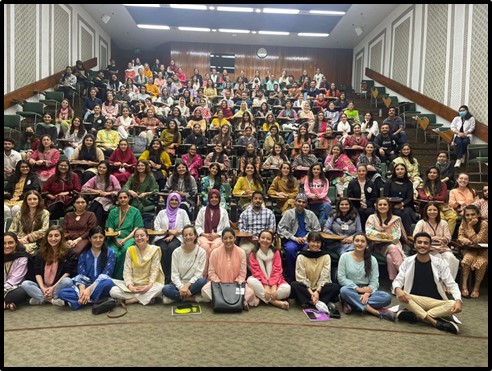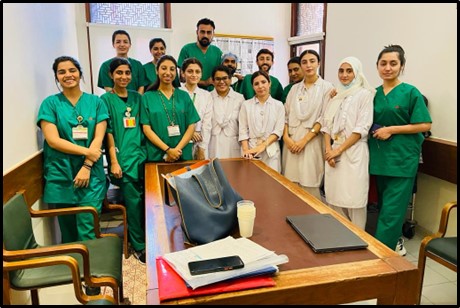In the realm of nursing, the path to educating and developing a skilled and empathetic healthcare provider is often filled with unexpected twists and turns. My personal experiences, from the first year to the final year, are marked by uncertainties and subsequent challenges for both me and my faculties. Whether it was dealing with physical hardships (delayed exams) or the psychological toll of demanding coursework, this path has been an endless chain of trials that kept our resilience to the test. Social and emotional turmoil was also at the forefront, reflected through crying spells and the need for constant emotional support from friends and faculty. Throughout my journey, alongside my faculties, we learned some essential strategies that could be used by our faculty members, bringing ease to our lives, even in the face of hardship.
In all four years of nursing school, I have suffered from health issues. Early on, a severe eye infection led to chalazion surgery in both eyes. The second year brought a double biopsy and, following months of observation, a lumpectomy. Even in my final year, a right elbow joint fracture added to the hurdles. All these health issues arrived on the cusp of my clinical rotation, an essential component of my nursing education that carried significant grades towards my final evaluation.

There is no question that students undergoing traumatic experiences encounter significant difficulties in successfully navigating the demands of nursing school. According to Blanco et al. (2020), nursing schools often expect that students should have excellence in academics, communication skills, critical thinking, emotional intelligence and teamwork, and must have a high resilience for adaptability to the challenging circumstances. Furthermore, in their journey at nursing school, clinical competency, time management and professionalism is anticipated in order to reflect an indicator of a great student (Blanco et al., 2020). This challenge, however, extends beyond students to also impact faculty members to cover the essential component, clinical rotations, which becomes a difficult task finding effective ways to assist and engage with students gaining clinical experience who are facing such hardships.
During mid-semester, faculty often confront situations where students are contending with amputations, extended recovery from fractures, recent surgeries, complex diagnostic procedures like lumbar punctures or biopsies, severe mental health issues, severe vision impairments, and various other hurdles. These circumstances present challenges for faculty members in ensuring that students receive the requisite exposure to mandatory clinical experiences, fulfilling the cognitive, affective and psychomotor domain of clinical education.
Facing this situation during my final year of program, I and my clinical faculty collaborated, to explore potential solutions to combat students' health concerns during clinical education. Through a comprehensive review of literature, we compiled a list of effective strategies that can be considered as alternative avenues for obtaining clinical experiences that can help students to achieve their big dream, completing their academic program successfully, and refraining from deferring semesters.
Strategies for faculty to improve student’s clinical experience
There were few strategies that my faculty members implied to soothe my journey of clinical practice. Similarly, following are the possible strategies for the clinical faculty members that they can pursue, to improve students' holistic learning during challenging times:
1. Understanding empathy: Faculty members should approach students with empathy, acknowledging the emotional impact of trauma. Many studies, including Pourhassan and Nazari (2021), have emphasized the significance of establishing appropriate emotional connections with learners. It appears that a substantial aspect of teacher education for instructing students, particularly young learners, centers on cultivating teachers' understanding of the importance of fostering caring and mutual ties with their students. Encouraging open communication is instrumental in providing students with a secure environment to openly share their struggles. In my personal experiences faculty members showed understanding and empathy by offering me alternative assignments and additional time was granted as soon as I receive the medical fitness certificate, allowing for makeup clinical sessions to compensate. Recognizing my limitations, with learning faculty members has always supported my emotional wellbeing by encouraging open communication where I felt comfortable sharing the struggles.

2. Devising flexible learning plans: In my own experience my faculty members played a crucial role by giving me extra hours for a flexible learning clinical area that helped me in promoting my semester, stabilizing my mental health and giving assurance with their clinical experience that things are working for my betterment. According to Williams et al. (2021) recognizing that each student's journey is unique, faculty can develop flexible learning plans that accommodate their needs while maintaining academic rigor. This might include choosing a clinical setting for students as per their limitations that would best serve them to gain clinical experience. Also it will help in planning or modifying class schedules, extended deadlines, or alternative assignments. This all will prevent from applying any semester affecting policies.

3. Using mental health resources: According to Baweja et al. (2015), teachers, as essential stakeholders, play an important role in successful mental health interventions in schools. They must view these interventions as aligning with the educational mission and recognize their benefits. In SONAM, our dedicated faculty extends their support beyond traditional academic roles, to provide holistic student experience. Faculty Advisers, Clinical Coordinators, and Academic Coordinators (AC Leads) play pivotal roles in providing counseling and emotional support during academic progression. Our campus facilities, including a gymnasium, swimming pool, walking tracks, indoor and outdoor sport annexures, wide-open green spaces, library, and cafeteria, are a few avenues for mental wellbeing. The facilities help to alleviate academic pressures, foster a versatile environment and promote networking and socialization within and beyond the AKU fraternity. Moreover, various committees such as sports, arts and culture, ACT society, Music society, Falah society, society for climate conversation and health, Synergy society organize events for students to create memories, rejoice and rejuvenate, with full zeal and zest. Complementing these efforts, the 'AURORA' student led a mental health society and a dedicated student psychologists associated with the Counseling office focuses on the mental health of the student body, in order to promote mental wellbeing by increasing awareness regarding mental health and reducing the stigma associated with it. As they say, your mental health is just as important as your physical health, indeed, all these activities facilitate students to overcome the challenges of their academic and clinical study load.
4. Formulating preceptor based clinical rotations: In my clinical experience, my faculties introduced me to preceptor-based clinicals, a structured learning environment where I had the opportunity to acquire hands-on skills under the guidance of a preceptor. Throughout this process, my progress was systematically documented using a sign-off checklist. This approach helped me identify and address my limitations, understand my work area, and develop strategies to overcome challenges, resulting in a focused and enriching learning experience. According to Williams et al. (2021), a recommended practice involves scheduling fixed clinical days for students with consistent preceptors to ensure learning continuity. This approach is especially valuable for students undergoing practical training as part of a makeup clinical rotation following a period of medical limitation and recovery. Moreover, Sandridge et al. (2011) also says, it will foster a mentor-student relationship that enhances student’s ability to apply theoretical knowledge in a clinical setting and explore avenues with a preceptor to choose their clinical environment as per their limitations for future clinical practice.

5. Creating simulation based education as a second-line to clinical: To address the challenge of completing practical requirements, faculty can consider simulation as a viable alternative. According to the Jeffries et al. (2015) ‘CCEI tool - Creighton Competency Evaluation Instrument can be used in simulation and clinical setting to measure and evaluate students clinical competency.’ This simulation exercise will allow students to practice essential skills in a controlled environment, ensuring they meet their learning objectives while mitigating physical limitations. Simulation has played a crucial role in my journey giving me a platform to learn and practice skills of critical care areas.
Conclusion
In a nutshell, the journey from trauma to triumph is a testament to the nursing students and faculty resilience during health-related uncertainties. In the world of nursing education, where challenges often arise unexpectedly, it becomes evident that inclusivity is the foundation of our shared experience. As we reflect on the experiences of bedside nurses, we are reminded that nursing is more than simply a job; it is a way of life and in the face of unpredictability, we understand the value of establishing an inclusive environment for all. Inclusivity, based on understanding and support, serves as the foundation for fresh perspectives. Through this lens, faculty members emerge as guides, directing students to achieve successful clinical learning outcomes. Physical limitation during clinical practice can surely impact the other components of holistic wellbeing. However, it is essential to ponder upon the diversity of students across race, religion, gender, family and cultural background, functional disability, all accepted under the wider umbrella of inclusive education. By embracing inclusivity, we not only improve the academic experience, but also ensure that every student, regardless of background or circumstance, feels a part of this nursing journey transforming process.
REFERENCES
- Baweja, S., Santiago, C. D., Vona, P., Pears, G., Langley, A. K., & Kataoka, S. H. (2015). Improving Implementation of a School-Based Program for Traumatized Students: Identifying Factors that Promote Teacher Support and Collaboration. School Mental Health, 8(1), 120–131. https://doi.org/10.1007/s12310-015-9170-z
- Blanco, M. Á. H., Puig-Llobet, M., Lluch‐Canut, T., Guàrdia‐Olmos, J., Arroyo, M. C. M., & Amador-Campos, J. A. (2020). Expectations of nursing degree students: A longitudinal analysis. Nurse Education Today, 92, 104474. https://doi.org/10.1016/j.nedt.2020.104474
- Jeffries, P. R., Dreifuerst, K. T., Kardong-Edgren, S., & Hayden, J. (2015). Faculty development when initiating simulation Programs: Lessons learned from the National Simulation Study. Journal of Nursing Regulation, 5(4), 17–23. https://doi.org/10.1016/s2155-8256(15)30037-5
- Pourhassan, A., & Nazari, M. (2021). Teachers learn to use critical incidents as a professional development tool in teaching young English learners. Innovation in Language Learning and Teaching, 17(1), 32–46. https://doi.org/10.1080/17501229.2021.1907751
- Williams, G., Hmaimat, N. A., AlMekkawi, M., Melhem, O., & Mohamed, Z. (2021). Implementing dedicated nursing clinical education unit: Nursing students’ and preceptors’ perspectives. Journal of Professional Nursing, 37(3), 673–681. https://doi.org/10.1016/j.profnurs.2021.04.002
- Sandridge, S. A., Newman, C. W., & Lesner, S. (2011). Becoming a better preceptor: The evaluation process. The Hearing Journal, 64(11), 18.https://doi.org/10.1097/01.hj.0000407399.56847.2c


